You'll keep moisture locked in your sun-cooked soups by implementing these seven proven techniques. Use dark metal cookware with a tight-fitting double lid system to trap steam effectively. Monitor temperatures every 20 minutes between 11 AM and 3 PM for ideal cooking conditions. Select airtight, leak-proof containers with proper vapor barriers to prevent moisture loss. Layer ingredients strategically, starting with hearty vegetables and adding delicate items last. Rotate your solar cooker every 10-30 minutes to maintain consistent heat. Keep the pot centered and sealed, and utilize moisture-rich ingredients like mushrooms and aromatics. These moisture-locking methods are just the beginning of mastering solar soup preparation.
Vapor Barrier Techniques
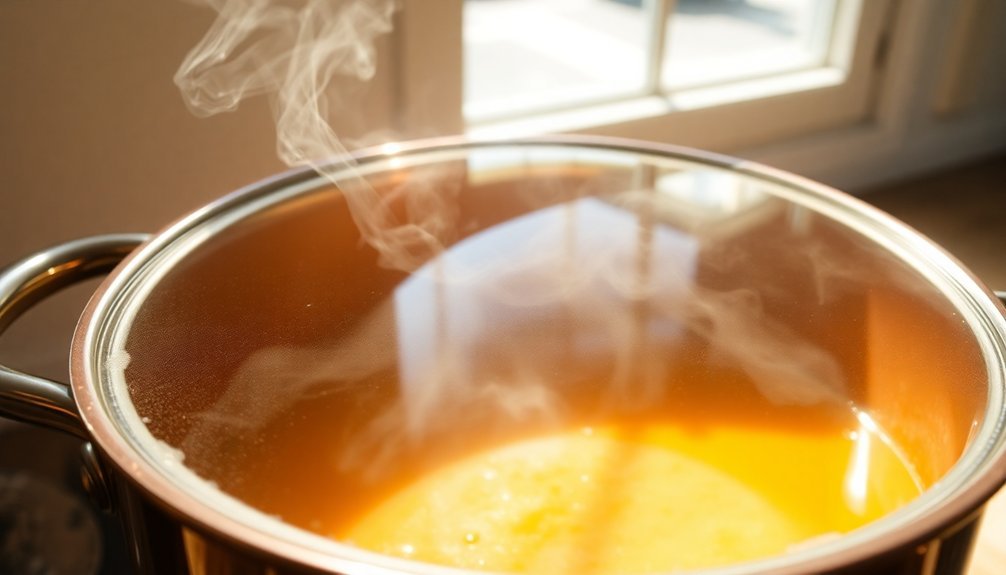
Four essential vapor barrier techniques guarantee proper moisture control in wall assemblies.
First, you'll want to use staples sparingly and only in overlap areas, covering them with sealing tape like VAST-R® or TAFTEX®. For a perforation-free installation, opt for double-sided tape applied directly to the substructure.
When it comes to sealing, you'll need to address both overlaps and penetrations using appropriate tapes. VAST-R® Sealpro or Butyl tape works well for wall and floor connections, while Tyvek® Flexwrap is ideal for complex penetrations.
Position your vapor barrier on the insulation's warm side to prevent condensation, and install a batten before mounting plasterboard. Proper installation significantly improves indoor air quality and temperature regulation.
Choose smart vapor retarder membranes that prevent diffusion while allowing interior moisture to dry, avoiding standard polyethylene sheets that can trap unwanted moisture.
Double-Lid Sealing Method
While vapor barriers protect walls from moisture, the double-lid sealing method offers a reliable way to lock moisture inside soups.
Using the Solid Status Solid 300 vacuum sealer produces optimal results for sealing soup packages.
You'll need to start by cooking your soup thoroughly and letting it cool slightly before proceeding with the vacuum sealing process.
- Pour your soup into an ice cream container and freeze it overnight to create a solid block, which prevents spillage during sealing.
- Choose a vacuum-sealing bag that's appropriately sized for your frozen soup block, typically 20×30, and roll down the top edges.
- Center the frozen block in your bag and align it carefully with your vacuum sealer's mouth.
- Activate the sealer and watch for the seal light to confirm completion, checking that there's no juice around the sealed area.
This method works with both traditional and compostable bags, ensuring your soup stays fresh and sealed.
Solar Cooking Time Control
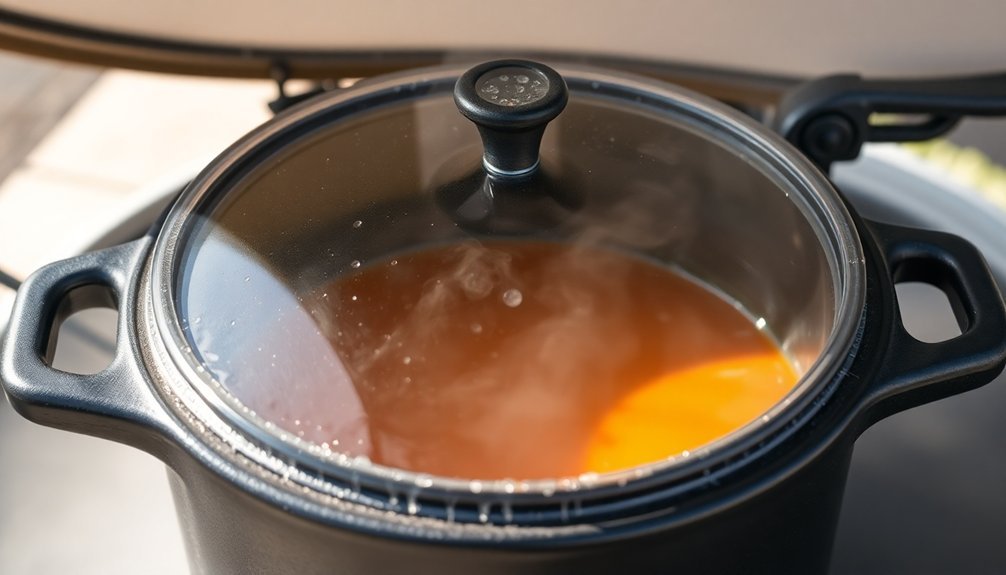
You'll get the best results cooking soups in your solar oven between 11 AM and 3 PM when sunlight is most intense, and you should check the temperature every 20 minutes to maintain consistent heat.
Use dark metal cookware for optimal heat absorption and faster cooking times.
Monitor your local weather forecast to plan ahead, as cloudy conditions can extend cooking times by up to three times longer than conventional methods.
Keep the pot centered and sealed with a lid while rotating the oven every 10-30 minutes to follow the sun's path, ensuring ideal heat retention throughout the cooking process.
Monitor Peak Sun Hours
Making the most of solar cooking requires understanding peak sun hours, which typically occur between 11:00 am and 3:00 pm when the sun reaches its highest position overhead.
You'll need to adjust your cooking schedule around these prime hours to guarantee your soups retain maximum moisture and flavor.
- Start preheating your solar cooker at least 30 minutes before cooking to maximize efficiency during peak hours.
- If you're in areas with shorter seasons, you can extend cooking from 10:00 am to 4:00 pm, but you'll need to monitor the cooker more frequently.
- Rotate your cooker every 30 minutes to follow the sun's path and maintain consistent heating.
- Consider using thermal mass like stones or bricks to help retain heat and stabilize your cooker, especially on windy days when moisture loss can be higher.
Temperature Regulation Methods
To maintain consistent cooking temperatures in your solar cooker, proper temperature regulation requires a combination of strategic positioning and insulation techniques.
Position your cooker to face the sun directly and readjust it every 30-45 minutes to track the sun's movement, keeping the reflective surfaces perpendicular to the sun's rays.
You'll need to monitor the internal temperature with a reliable thermometer, aiming for 150-225°F.
Add multiple layers of insulation around the cooking cavity using materials like crumpled newspaper or dry leaves. For ideal heat retention, use dark-colored cookware with tight-fitting lids and line your reflectors with aluminum foil or Mylar tape.
Adding thermal mass, such as a brick, will help stabilize temperatures. Remember to keep the glazing material securely sealed to prevent heat escape.
Timing By Weather Conditions
Beyond temperature control, successful solar cooking depends heavily on understanding and adapting to weather conditions throughout the year.
You'll need to adjust your cooking schedule based on seasonal changes and daily weather patterns to keep moisture locked in your soups.
- During summer, you'll find the best cooking window between 10 AM and 4 PM, with peak temperatures from 11 AM to 3 PM – perfect for maintaining consistent soup temperatures.
- In winter, plan for longer cooking times and more frequent sun tracking to compensate for reduced UV intensity.
- On cloudy days, you'll need to extend cooking times and use booster panels to maintain steady temperatures for your soups.
- Watch for strong winds that can destabilize your solar cooker – choose sheltered spots to prevent heat loss and maintain moisture in your soups.
Proper Container Selection
Selecting the right container for storing your soup can make the difference between preserving its flavor and ending up with freezer-burned leftovers.
You'll want to choose containers with airtight seals and leak-proof lids to lock in moisture and prevent freezer burn.
BPA-free plastic and polypropylene containers are practical choices, as they're lightweight and can withstand temperatures from -40°F to 160°F.
If you're environmentally conscious, glass or silicone containers offer durable, reusable options.
Consider your portion needs when selecting container sizes – smaller containers work best for individual servings, while larger ones suit batch cooking.
Make sure your containers are microwave and freezer-safe for convenient reheating.
Look for stackable designs to maximize freezer space, and don't forget to label them clearly with contents and dates.
Steam Circulation Management
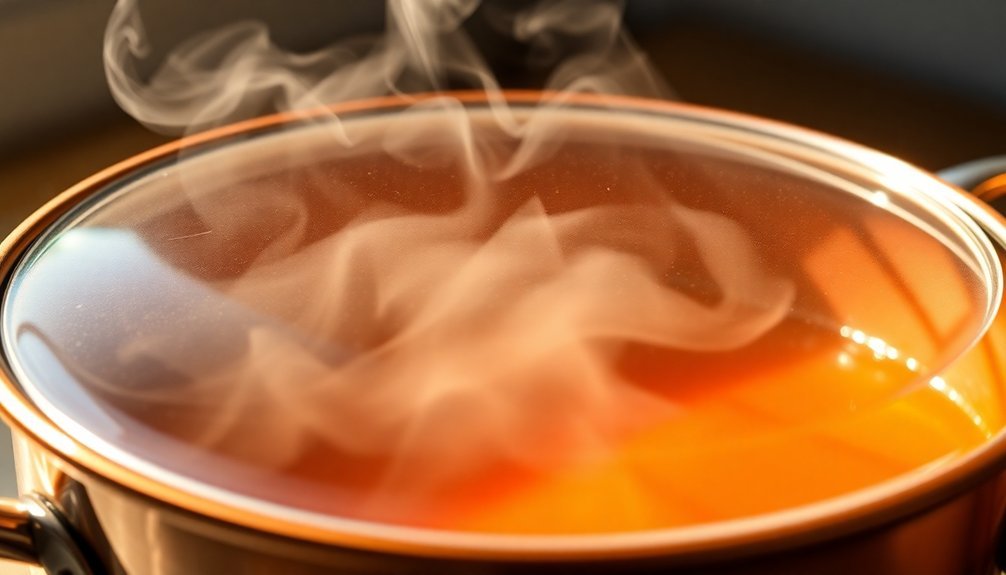
Managing steam circulation effectively can revolutionize your soup-making process through advanced technologies like Steam Infusion. You'll achieve near-perfect energy transfer while preserving the integrity of your ingredients by using direct contact heating that condenses steam on the liquid surface.
- Control your steam flow using a Vaction™ Pump to rapidly heat 1,000kg of soup from 20 to 85°C in just 10 minutes, ensuring consistent cooking throughout.
- Keep vegetables and meat chunks intact with the 47mm uninhibited bore, preventing unwanted breakdown during the cooking process.
- Retain more flavor volatiles by utilizing precise temperature control, reducing the need for additional spices by up to 50%.
- Maximize energy efficiency by cutting consumption from 500 kWh to less than 250 kWh per tonne, while maintaining ideal moisture levels in your final product.
Temperature Monitoring Strategies
Proper temperature monitoring serves as the cornerstone of safe and successful soup preparation. When using your solar cooker, you'll need to track temperatures carefully through each phase of cooking and cooling.
Keep your soup out of the danger zone (40-140°F) by cooling it rapidly – first from 140°F to 70°F within 2 hours, then to 40°F in the next 4 hours.
Use a reliable food thermometer to check temperatures regularly, and record your readings. You can speed up cooling by dividing your soup into shallow containers no deeper than 3 inches or using ice-filled cooling paddles.
Once cooled, store your soup on the top shelf of your refrigerator, leaving it uncovered until it reaches 40°F. Remember to label and date containers, and consume or freeze within 4 days.
Ingredient Layering Techniques
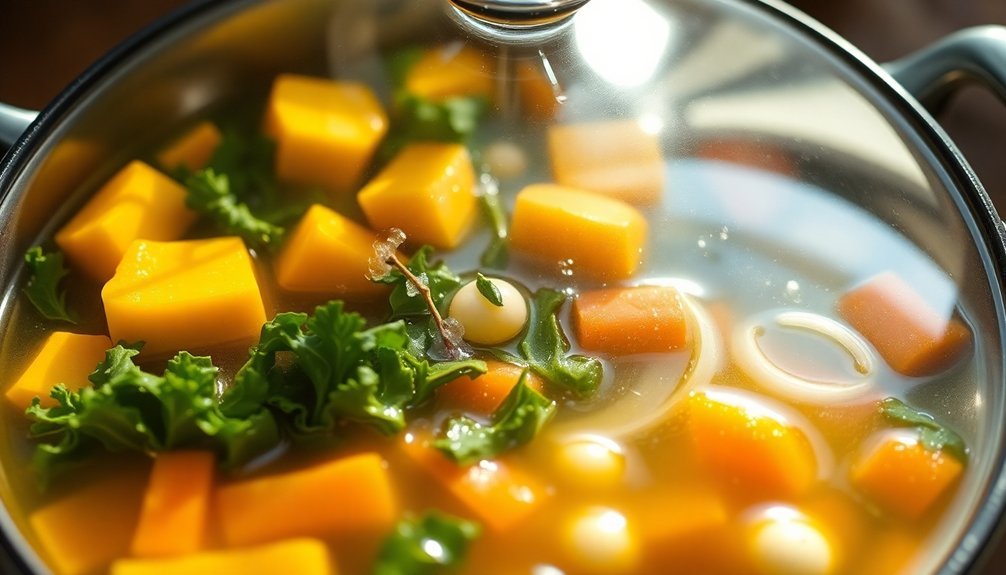
To build rich, complex flavors in your soup, strategic ingredient layering plays a significant role. You'll want to start by browning your meat and bones, followed by aromatic vegetables to create a flavorful foundation. This process releases complex flavors and creates valuable browned bits that'll enrich your broth.
- Begin with hearty ingredients like potatoes and broccoli, giving them enough time to cook thoroughly.
- Add your aromatics like onions, garlic, and celery, followed by mushrooms and dried herbs.
- Pour in your broth after browning to capture all the concentrated flavors.
- Save delicate ingredients for last – leafy greens, fresh herbs, and final seasonings.
This layering technique guarantees each ingredient maintains its best texture while contributing its unique flavors to your soup.
Frequently Asked Questions
Can Sun-Cooked Soups Be Safely Stored in Traditional Clay Pots?
You can store sun-cooked soups in clay pots if you've properly seasoned them and follow safety guidelines. Cool the soup first, use an inverted lid with a paper towel, and store in a well-ventilated area.
How Does Altitude Affect Moisture Retention in Sun-Cooked Soups?
At higher altitudes, you'll notice faster moisture evaporation in your sun-cooked soups due to lower humidity. You'll need to add extra liquid, keep the pot covered, and monitor cooking time more closely.
Will Adding Wine to Sun-Cooked Soups Increase Moisture Loss?
Yes, adding wine to your sun-cooked soups will increase moisture loss. As the wine evaporates during cooking, it'll pull additional moisture with it. You'll want to compensate by adding extra liquid ingredients.
Does Stirring Frequency Impact Moisture Retention During Solar Cooking?
You shouldn't stir frequently during solar cooking, as opening the oven releases trapped heat and moisture. It's best to let your food cook undisturbed, which helps maintain ideal moisture levels throughout cooking.
Can Magnetic Lids Improve Moisture Retention Compared to Regular Lids?
No, magnetic lids won't improve moisture retention compared to regular lids. You'll get better results with traditional canning lids that have proper sealing mechanisms. Magnetic lids are mainly designed for organization, not moisture control.
In Summary
You'll find these seven moisture-locking techniques transform your solar cooking experience. By implementing proper sealing methods, time management, and strategic ingredient layering, you're ensuring your sun-cooked soups retain maximum flavor and nutrition. Don't forget to monitor temperature and manage steam circulation carefully. With the right container and vapor barrier approach, you'll master the art of moisture retention in solar cooking.

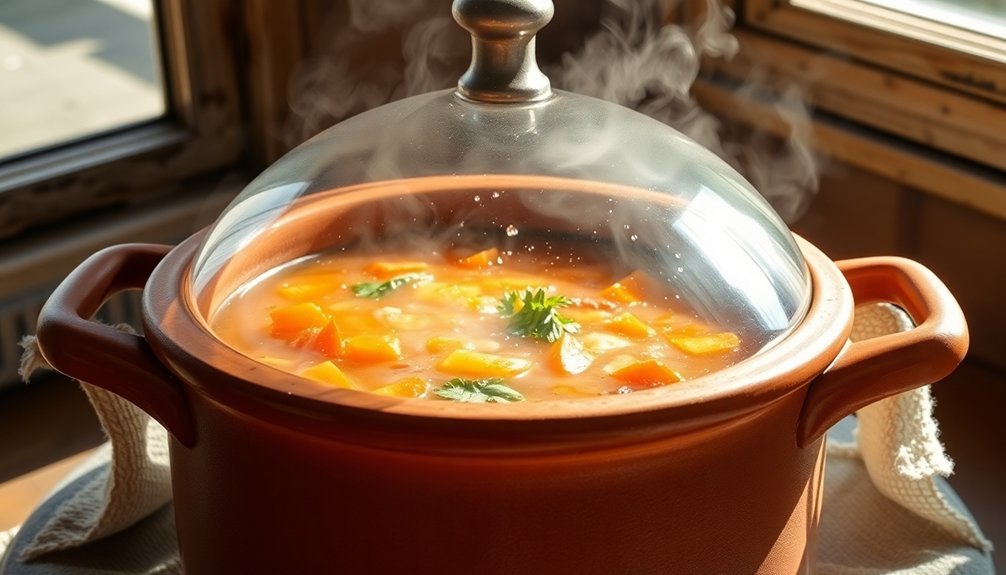



Leave a Reply